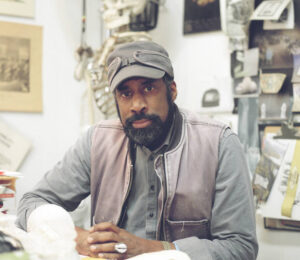Nari Ward

We The People (1990’s)
This was Ward’s first solo exhibition. A large portion of the works in this exhibition were from the 1990’s, issues of this period such as poverty, racism, consumer and material culture still resonating today.

Amazing Grace (1993)
This exhibition consisted of over 250 dilapidated baby strollers that Ward found abandoned. These were arranged around an aisle of flattened fire hoses, accompanied by Mahalia Jackon’s voice singing Amazing Grace. This is meant to push viewers to think of the lives these strollers once had and held, be it children or the possessions of the homeless, a commentary on the early 1990’s New York, the state of Harlem and the devastation caused by the drugs and AIDS epidemics. In addition to this, Ward also reaches back into the histories of colonialism and slavery, the fire hoses arranged on the floor being echoes of the hull of a ghost ship.

Sky Juice (1993)
This monument was made from an iron fence, overgrown with dilapidated textiles which look like entrails. It is intended to reference Jamaican drinks sold by street vendors, made out of ice, syrup, and water, poured in a bag and drank through a straw. The fence holds up a shredded umbrella, mutilated plastic bottles filled with photographs, and clumped textiles coated in sugar and Tropical Fantasy soda (originally founded in Brooklyn and gained popularity in poorer neighborhoods). Tropical Fantasy was rumoured to have been laced with an agent capable of sterilising Black men.

Breathing Panels (2015)
Through this piece of work, Ward looks at history, and unrepresented or marginalized voices in history, and how it is constantly evolving. Acknowledging that history tells a particular story, Ward puts forth the idea that there are also a multitude of stories which remain untold, that remain invisible within the one or few mainstream narrative/s. This is not so much an idea of ‘replacement’, but bringing this new form or portrayal to the forefront, simultaneously destabilizing it, so that it acts as a placeholder for other possibilities or somebody else’s narrative/s

Breathing Circles (2018)
This series was made in copper, and references a Congolese cosmogram which represents birth, life, death, and rebirth, and also served as breathing holes for runaway enslaved people who hid under church floorboards on the Underground Railroad. For Ward, seeing the magic and power of these patterned holes on the floor conveyed, the idea was that these enslaved people were trying to preserve their history in this important form of resistance – the coded breathing hole pattern on the floors that served as space for the basement’s ventilation. To Ward, this was a powerful thing that was preserved and used in a radical way, the holes were both visible and invisible at the same time.
